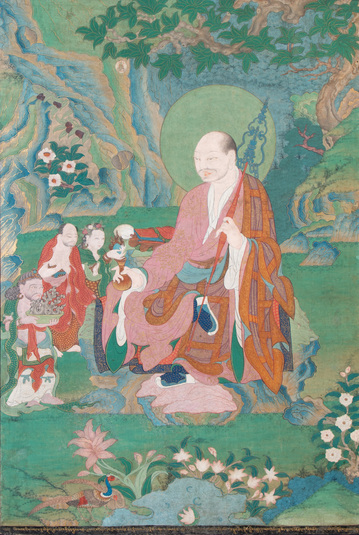
Item: Arhat/Sthavira (Buddhist Elder) - 16 Elders: Nagasena
| Origin Location | Tibet |
|---|---|
| Date Range | 1700 - 1799 |
| Lineages | Buddhist |
| Material | Ground Mineral Pigment on Cotton |
| Collection | Anna Maria Rossi & Fabio Rossi |
Classification: Person
Appearance: Arhat
Gender: Male
Nagasena the Elder (Tibetan: ne ten, lu'i de. Sanskrit: Sthavira Nagasena) from a set of paintings depicting Shakyamuni Buddha, disciples and the Sixteen Great Elders (sthavira/arhat).

Nagasena appearing slightly old holds a vase in the right hand and a monk’s staff in the left leaning against the shoulder. In typical Chinese style the Sixteen Elders (lohan) are depicted wearing colouful robes and shoes. He is seated in a relaxed manner atop a rocky seat. To his side are three figures making offerings of a wish-fulfilling jewel and a philosopher’s stone. A very small Buddha figure can be spotted high up in the composition.
"On the King of Mountains, Vipulopa is the noble elder Nagasena, surrounded by 1,200 arhats; homage to the One holding a vase and a khakkhara staff." (Sakya liturgical verse).
The Sixteen Great Arhats are generally painted as a set. Typically the full group would include the Buddha Shakyamuni with the two foremost disciples Shariputra and Maudgalyayana, the Sixteen Great Elders, the attendant Dharmatala, the patron Hvashang and the Four Guardians of the Directions: Vaishravana, Virupaksha, Dritarashtra and Virudhaka.
A lengthy verse inscription at the bottom is taken from a Praises to the Sixteen Elders written by the 5th Dalai Lama Ngagwang Lobzang Gyatso. “The vase of Nagasena was offered along with many other precious vessels by the Four Guardian Kings in order to receive refuge in the Three Jewels and to benefit all beings. The divine [water] of the vase will cleanse karmic obscurations. Whoever hears the sound of the staff will be cleansed of all sickness, freed from all suffering and the afflictions will be pacified, and [all will] obtain faith in the Three Jewels.”
Jeff Watt 3-2002 [updated 6-2018]
Collection: Kapoor Galleries
Collection of Anna Maria Rossi & Fabio Rossi
Arhat/Sthavira: Main Page & Arhat/Sthavira Appearance (Elder)
Arhat/Sthavira: Nagasena Main Page
